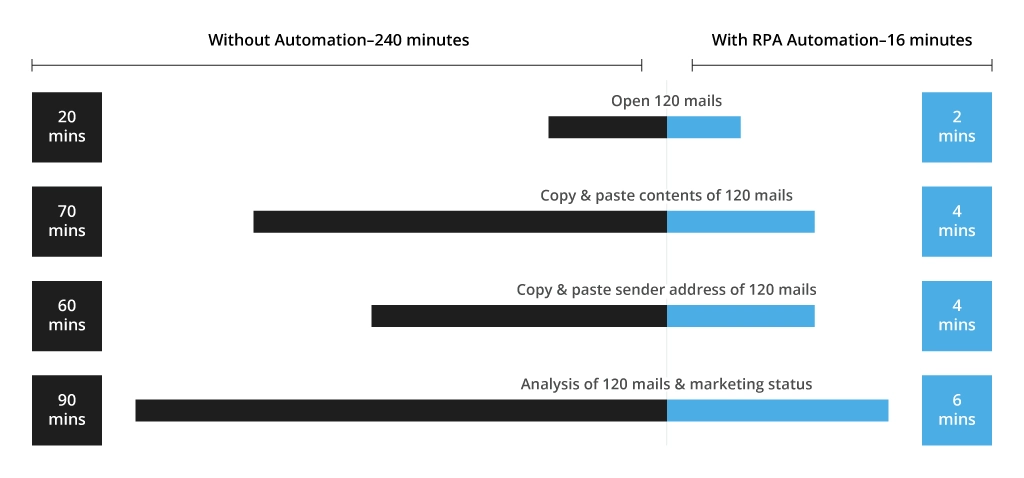Essential KPIs and Metrics to Measure the Value and Cost-Effectiveness of Your RPA Solution
We live at the center of disruptive global events: labor constraints, supply chain disruptions, public health concerns, international conflicts, and recession risks. But the business world always finds ways and tools to adapt. The State of Intelligent Automation Report 2022 reflects a clear trend: 92% of organizations are leveraging intelligent automation to navigate the complexities of global events and secure their long-term success.
As the world continues to change rapidly, the strategic adoption of intelligent automation will prove essential in driving growth, innovation, and adaptability in the face of uncertainty. RPA is a starting point on a hyperautomation journey, it sets the stage for the broader intelligent automation vision, where multiple automation technologies synergize to drive comprehensive business transformation.
The primary goal of RPA is to automate repetitive, rule-based tasks performed by humans and delegate them to diligent software robots. As evident from the graph below, the ultimate simplicity and efficiency of this tech have made robotic process automation the most widely embraced intelligent solution among enterprises.
As enterprises embark on their automation quest and implement RPA solutions, it becomes imperative to establish a clear set of Key Performance Indicators to measure the impact and financial viability of these automation initiatives. Let’s discuss them in more detail.
Six-Step Plan to Evaluate RPA Progress
After having integrated RPA into your workflow, how do you quantify the benefits of automation? In other words, how do you measure RPA success and ROI? To gauge the success and impact of RPA, organizations need to establish Key Performance Indicators (KPIs) and metrics that align with their automation objectives. Make sure to test your strategy against these 6 points:
- Define Clear Objectives: Start by establishing specific objectives for your RPA initiative. These objectives should be aligned with the overall business goals, such as improving productivity, reducing operational costs, enhancing accuracy, or increasing customer satisfaction.
- Identify Relevant KPIs: Based on your defined objectives, identify the key performance indicators that will measure the success of your RPA implementation.
- Set Baselines and Targets: Establish baseline values for each identified KPI before proceeding with RPA. This baseline will serve as a point of comparison to assess the impact of automation.
- Implement Reporting Mechanisms: Deploy tools and systems to track and record relevant data related to the identified KPIs. These may include RPA analytics platforms, business intelligence tools, or custom-built reporting dashboards.
- Gather Feedback from Stakeholders: Engage with stakeholders, including employees, process owners, and customers, to gather qualitative feedback on the impact of RPA. Understanding their experiences and perceptions can complement the quantitative KPI measurements and provide valuable insights to improve the process.
- Regular Evaluation and Adjustment: Periodically assess the overall impact of RPA against the defined objectives and targets. As business needs evolve, make necessary adjustments to the automation strategy to ensure continued relevance and effectiveness.
Defining Key Performance Indicators (KPIs) for RPA Success
Operational Efficiency Metrics
- Process cycle optimization
Measure the time taken to complete a specific process before and after RPA implementation. A shortened process cycle is a clear indication of the improved efficiency.
Example: An advanced RPA solution is now automating up to 3,700 tasks per day for our customer, a process that was manual and cumbersome before.
- Error rate reduction
Track the number of errors occurring during manual processing versus automated processing. With lower error rates, you will spend less time and effort editing and revising tasks.
Example: With RPA, the error rate in order processing decreased from 5% to less than 1% (only 1 out of every 100 orders contained mistakes or inaccuracies). This reduction in errors not only translated into higher customer satisfaction but also led to substantial time and cost savings.
- Resource optimization
Measure the resource allocation and workforce productivity before and after RPA implementation. RPA should free up human resources for high-value tasks.
Example: After Infopulse implemented an RPA solution , the financial department of an oil and gas company reduced the time spent on data entry by 70%, allowing staff to focus on strategic initiatives.
Cost and Savings Metrics
- FTE (Full-Time Equivalent) reduction
Calculate the number of full-time employees required for a process without RPA and compare it to the reduced number of employees after automation.
Example: We implemented RPA in the finance department of a construction company which reduced the need for five full-time employees, resulting in substantial cost savings.
- Cost per transaction reduction
Measure the cost incurred to execute a single transaction before and after RPA. If the comparison shows some cost decrease, you’ve achieved the desired outcome.
Example: Our client, an Icelandic healthcare institution, had its overall annual total cost (TC) expenses reduced by $75,000+ by integrating an automation solution into their operations.
- Cost savings from improved compliance
Calculate cost savings resulting from reduced compliance violations and associated fines or penalties. RPA implementation ensures better adherence to industry regulations, thus saving the companies thousands and sometimes millions in compliance-related expenses.
Quality Metrics
- Accuracy improvement
Measure the accuracy of process outputs with and without RPA. Look for minimized errors and increased precision.
Example: RPA implementation in data entry reduced data errors by 90%, leading to improved data accuracy.
- Process adherence and consistency
Assess the level of adherence to standard operating procedures and consistency in process execution achieved through RPA.
Example: Infopulse helped a Nordic municipality automate the process of bulky data migration, decreasing time and saving costs with an RPA solution. The robots executed each step consistently, eliminating the variability that often arises in manual processes. This consistency not only bolstered data integrity but also enhanced the overall efficiency of the municipality's operations.
- Compliance with regulations and policies
Monitor the organization's compliance with industry and internal policies facilitated by RPA.
Example: RPA can help healthcare providers adhere to HIPAA regulations, mitigating the risk of data breaches and non-compliance fines.
Customer Experience Metrics
- Faster Data Entry
Track the time taken to input billing and order data with the assistance of RPA. From day one you will see how the time-consuming process of data entry speeds up with RPA inclusion. Faster and error-free data entry translates into a smoother customer experience. Satisfied customers are more likely to perceive the service positively.
- Enhanced Service Delivery
Evaluate the overall improvement in service quality and delivery after RPA adoption. The accelerated data entry will help boost the entire customer service and bring about greater efficiency.
Example: In order processing, RPA integration enables faster order fulfillment and minimized delivery times.
Evaluating Cost-Effectiveness of Your RPA Solution
To ensure the success of your Robotic Process Automation (RPA) transformation and justify the investment, it is essential to perform a comprehensive cost-effectiveness evaluation. The primary approaches include cost-benefit analysis and ROI calculation.
1. Cost-Benefit Analysis
- Calculate the total cost of implementing the RPA solution, including software licensing, development, implementation, and training costs.
- Then, assess the quantifiable benefits achieved with RPA, such as reduced labor costs, increased productivity, and process optimization.
- Measure the cost savings resulting from the reduction in Full-Time Equivalents (FTEs) required to execute the automated processes and the decreased cost per transaction achieved through automation.
- Do not forget about the intangible and long-term benefits of RPA, such as error reduction, improved accuracy, enhanced compliance, and risk mitigation.
2. ROI Calculation
Calculate ROI by subtracting the initial cost of the investment from its final value. Next, divide this result by the cost of the investment, and finally, multiply the outcome by 100 to express it as a percentage.
Example: If your net financial gains from RPA over one year amount to $150,000 and the initial cost was $100,000, you would calculate ROI as follows: ROI = (($150,000 - $100,000) / $100,000) x 100 = 50%
3. RPA scalability
Assess the potential for scalability and the long-term impact of the RPA solution on business processes and overall organizational performance.
To Summarize
Intelligent automation is one of the tools organizations utilize to adapt to global events and disruptions. RPA can help businesses maintain resilience, productivity, and cost-effectiveness against financial challenges and unfavorable economic conditions. With a coherent set of KPIs and cost-effectiveness evaluations, enterprises ensure the success and justification of their RPA investments.
![RPA KPIs and Metrics [Main Banner]](https://www.infopulse.com/uploads/media/banner-1920x528-how-to-measure-rpa-kpi-rpa-metrics.webp)







![RPA Bots in Agriculture [thumbnail]](/uploads/media/thumbnail-280x222-the-potential-of-RPA-bots-in-agri.webp)
![Hyperautomation use cases [thumbnail]](/uploads/media/thumbnail-280x222-top-hyperautomation-use-cases-and-examples.webp)
![Robotic Invoice Process Automation [thumbnail]](/uploads/media/automating-invoicing-with-rpa-280x222.webp)
![RPA Licensing Cost Optimization Guide [thumbnail]](/uploads/media/thumbnail-280x222-a-guide-to-optimizing-licensing-costs-when-adopting-rpa.webp)
![Guide to Security Automation [thumbnail]](/uploads/media/enterprise-guide-to-security-automation-280x222.webp)
![RPA vs Intelligent Automation vs Hyperautomation [thumbnail]](/uploads/media/how-to-move-from-rpa-to-intelligent-automation-or-hyperautomation-280x222.webp)




![Cross-Industry RPA Benefits [thumbnail]](/uploads/media/cross-industry-benefits-of-robotic-process-automation-rpa-280x222_v2.webp)